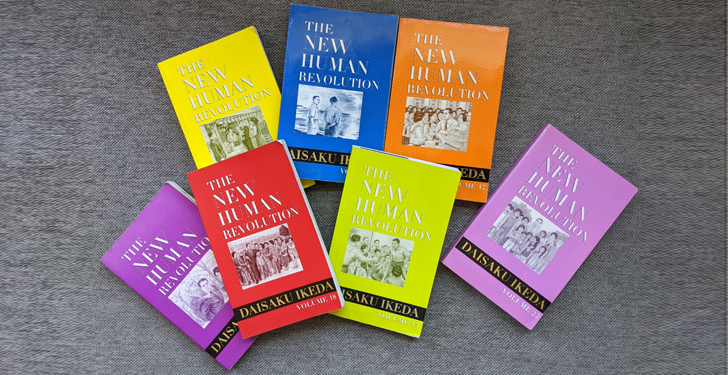On Aug. 14, 1957, 10 years to the day since meeting Josei Toda, Ikeda Sensei was in Karuizawa, Nagano Prefecture, attending to his ailing mentor.
They discussed how Mr. Toda would compose his Declaration for the Abolition of Nuclear Weapons, which he delivered a month later on Sept. 8. This declaration became his final injunction, through which he entrusted the youth to create lasting peace by spreading Nichiren Buddhism throughout the world.
As he talked with him that day, Sensei decided to transmit for posterity the life and legacy of his mentor and second Soka Gakkai president by writing a novel, The Human Revolution.
On Dec. 2, 1964, Sensei commenced writing The Human Revolution, which was serialized in the Seikyo Shimbun (the Soka Gakkai’s daily newspaper). It was an epic work eventually comprising 12 volumes. It chronicles Mr. Toda’s efforts to carry on the legacy of his mentor, founding Soka Gakkai President Tsunesaburo Makiguchi, as he rebuilt the Soka Gakkai and led it to unprecedented growth. It also introduces Mr. Toda’s young disciple Shin’ichi Yamamoto (the character depicting Sensei), ending with Shin’ichi’s inauguration as third president on May 3, 1960.
Sensei completed the novel on Feb. 11, 1993—on what would have been Mr. Toda’s 93rd birthday—and the Seikyo Shimbun published the final installment on April 2, the 35th anniversary of his mentor’s passing.
“Peace Is the Most Basic Starting Point”
Aug. 6, 1993, marked 48 years since the atomic bomb was dropped on Hiroshima. Early that morning, Sensei began writing The New Human Revolution, which opens with the lines:
Nothing is more precious than peace. Nothing brings more happiness. Peace is the most basic starting point for the advancement of humankind. (vol. 1, p. 1)
Elaborating on this deep resolve for peace, he writes:
Mahatma Gandhi proclaimed that the “power of the spirit” is stronger than any atomic bomb. To transform this century of war into a century of peace, we must cultivate the limitless inherent power of human life. This is the “human revolution,” and it will be the theme that flows consistently throughout the series. (NHR-1, xi)
That Aug. 6, Sensei welcomed leading Gandhian philosopher professor N. Radhakrishnan to the Soka Gakkai Nagano Training Center in Karuizawa.
During their discussion, Sensei showed him the first page of his freshly written manuscript. The professor said he felt: Here is a man living out his life to realize the vision and dreams of his mentor (see Aug. 6, 2020, Seikyo Shimbun, p. 3).
While Sensei wrote The Human Revolution to eternalize Mr. Toda’s legacy, The New Human Revolution portrays the great path of disciples carrying on that legacy with Sensei leading the way.
Continuing Dramas of Human Revolution
Karuizawa is a place of deep significance. It is where Sensei resolved to write The Human Revolution during that last summer with his mentor; where he began writing its sequel, The New Human Revolution, on Aug. 6, 1993; and where, exactly 25 years later, on Aug. 6, 2018, he completed his 30-volume work at age 90.
Sensei, at 65, began writing the novel, fully aware of the intense struggle it would entail to complete it within his lifetime. Describing his intent in putting pen to paper every day, he says:
Each day was a battle into which I poured my heart and soul. Calling to mind my precious fellow members in Japan and around the world striving so earnestly in faith, I tapped the deepest recesses of my being to write my tale, as if I were sending a letter of encouragement to each one of them. At the same time, I was also engaging in an inner dialogue with my mentor as I wrote. His voice would echo in my mind, urging me to transmit the Soka Gakkai spirit for posterity and fulfill my mission in this life. That would sweep away all weariness and fill me with courage. (March 2019 Living Buddhism, p. 14)
On Sept. 8, 2018—the 61st anniversary of his mentor’s anti-nuclear weapons declaration—the last installment of this novel was published in the Seikyo Shimbun.
Upon finishing his 30-volume work, which he describes as “the epic story of kosen-rufu and the victory of ordinary people,” Sensei calls on us all, his disciples: “That epic will not end with the completion of the novel.
“While dedicating ourselves forever to fulfilling the shared vow of mentor and disciple, let’s continue writing an enduring ‘day-to-day record’ of brilliant achievements and triumphs for ourselves and others. May the light of human revolution shine eternally!” (Oct. 12, 2018, World Tribune, p. 3)
Purchase The New Human Revolution in various formats here:
Books, vols. 1–26: bookstore.sgi-usa.org
E-books, vols. 1–13, 23, 24: amazon.com and other online booksellers
Audiobooks, vols. 1–6: audible.com and other audiobook sellers
You are reading {{ meterCount }} of {{ meterMax }} free premium articles

